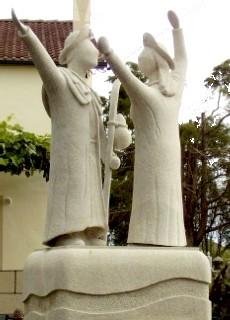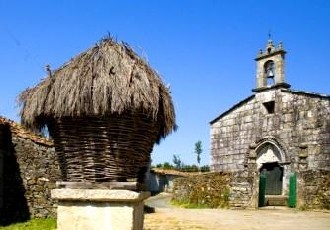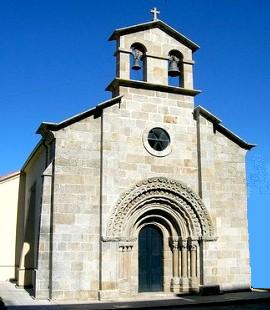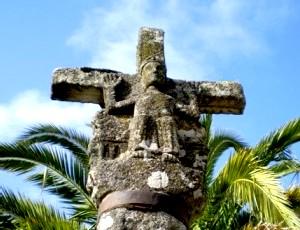Camino de Santiago - French Way - Stage 31, page 1
Palas de Rei to Arzúa
Total distance - 31.7 km
Depart Palas de Rei passing the modern Santiago Peregrino statue and down onto a path running alongside the main road passing through the village of Carballal and the hamlet of A Laguna before arriving at San Xulián do Camino where there is a small albergue which offers an evening meal.

There is a sad story which surrounds San Julián. On the day he was born the poor man was cursed by witches to commit the horrific murder of his parents. It was to be many years later and was whilst out hunting that Julián was warned by a deer that this would happen and in order to avoid the curse he moved away without telling his parents where he was going and ended up in Galicia. As any good parents they eventually tracked him down and after their long journey they wished to rest and Julián's wife offered them the marital bed for them to sleep in. Julián was again out hunting at the time his parents had arrived so he did not know what his wife had done and the devil came to him telling him that the people in his bed were his wife and a lover. Taking his sword he murdered the people in his bed only to realise soon after that he had murdered his parents as had been foretold. So distressed was he that he and is wife undertook a pilgrimage to Rome to ask for forgiveness and to offer to set up a hospital for pilgrims. Julián eventually built more than 7 hospitals and several houses offering respite to the poor and weary.
The legend says that an angel came to him a few years later and forgave him but another version says that it was Jesus Christ himself that forgave him. The devil is said to have disguised himself as a pilgrim who wrecked one of Julián's houses which led Julián to declare he would never take anyone else in and ordered everyone to leave. Jesus then, also disguised as a pilgrim, approached San Julián for shelter and was turned away. Jesus asked Julián to hold his walking stick which stuck to his hands and only then did he realise who was in front of him and asked for his forgiveness which Jesus gave. To this day San Julián is known as the patron saint of travellers, innkeepers and hunters amongst a number of other things including circus workers.
We now continue along the path crossing the Río Pambre up into the hamlet of Pontecampaña where you can stay at the small albergue and then back on the road through some woods towards the village of Casanova where there is a Xunta albergue and a local restaurant that does evening meals and breakfast.
From Casanova the route takes you through the hamlets of Porto de Bois, Campanilla and O Coto where there is a bar/restaurant. Shortly after leaving O Coto you leave the province of Lugo and enter the province of La Coruña. From here you will find that the stone markers now indicate changes of direction as well as giving you the name of where you are and how many kilometres to Santiago. Continuing to follow the markers you will soon come to the village of Leboreiro.

This village owed much of its existence to the Camino and declined somewhat in the years following the Camino's peak. Opposite the 13th century Iglesia de Santa Maria is the building that used to be the pilgrim hospital known as the Casa de la Enfermería which was founded by the noble Ulloa family, whose coat of arms can be seen on the façade. In front of the church is an interesting wooden/thatched structure which is known in this region as a Cabazo. This like the horreos you will have passed on your journey, were and still are used to store corn. The cobs get placed in here to keep them dry and out of reach of rats and other animals that enjoy eating them.
The church itself has an interesting legend surrounding it. The legend tells that one day water began to flow from a fountain close by, not unusual you would say, but this fountain would emit a beautiful smell during the day and provide light during the night. The locals believed it to be a miracle and taking turns they dug around the fountain and found a statue of the Virgin Mary. They immediately moved it to the church, but each night the Virgin would go back to the fountain and the villagers would then return it back to the church in the morning. This went on and on until a local artist had the idea of sculpting the image of the Virgin Mary on the tympanum of the church. Once this had been completed the villagers once again moved the statue of the Virgin Mary into the church and this time, with her ego satisfied, the Virgin decided to stay put, though it was rumoured that she still left each night to go to the fountain to brush her hair.
In terms of accommodation, there is a small albergue in the village which is open all year.
Back on the route walk through the village and over the Puente María Magdalena crossing the Río Seco and through the hamlet of Disecabo passing by a picnic/rest area marked by a large cross placed here by the Knights of Santiago. The path now detours from its original route down the main road through an industrial estate. It was done to make the route a bit safer. Soon after passing through the industrial estate you will come to the mediaeval Puente Velha which spans the Río Furelos and into the village of Furelos.
There is a small church Igrexa de San Xoán (Iglesia de San Juan) in the village which does offer guided tours. The village, like so many other, used to have a pilgrim hospital but nothing remains of it. As you pass through the village you may spot that some of the houses still have their medieval doors. There is a small bar if you want to get some refreshments. From Furelos the route into Melide is a short one, approximately 1.5 kilometres.
The origins of Melide go way back, over 4,000 years, evidenced by the dolmens or burial chambers that can be found dotted around the locality. The actual town of Melide dates back to the 10th century but it appears to have gained more prominence when King Alfonso IX gave the land surrounding Melide to the Archbishop of Santiago in 1212 AD. In 1320 Archbishop Berenguel de Landoira built a castle and walls in the town to fortify it but these were destroyed during the Irmandiños uprising and after that the Catholic Monarchs Ferdinand and Isabella prohibited its reconstruction.
Melide is found pretty much centrally in Galicia and is where two of the Caminos meet, the Camino Frances that we have been following and the Camino Primitivo which begins in Oviedo in Asturias. If you want to find out some more history about the town and the area visit the Museo da Terra de Melide. The museum is housed in the former Hospital de Peregrinos which had been part of a Franciscan monastery founded in the 14th century by Fernán López and his wife Aldara González who donated a number of houses to be used by the monks.

Also in the town is the 18th century Capilla de San Roque. This church was built using the stone from two former churches that of Sano Pedro and the original Capilla de San Roque which used to be where the Caja de Ahorros now stands. Inside the church is a plaque with an inscription commemorating the former churches.
To the left hand side of the chapel next to a large palm tree is the 14th century stone Cruceiro do Melide, said to be the oldest such cruceiro in Galicia according to the renowned Galician writer Alfonso Daniel Rodríguez Castelao.
 Only the top half is original, the bottom stone pole is a modern addition. It is believed that it may have originally been part of the former Iglesia de Sano Pedro.
Only the top half is original, the bottom stone pole is a modern addition. It is believed that it may have originally been part of the former Iglesia de Sano Pedro.
In the centre of the town in the Plaza del Convento you will find the 14th century Iglesia de Sancti Spiritus, all that is left of a former Franciscan monastery. As with many churches of this age it has undergone a number of refurbishments and additions and contains a variety of building styles such as baroque, neoclassical and gothic. It is also said to have been built from stone from the castle that had been built by the Archbishop of Santiago Berenguel de Landoira.

